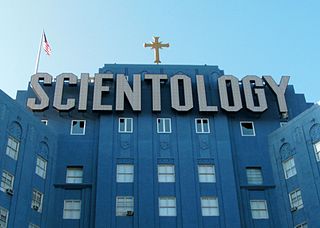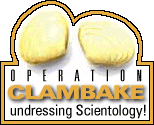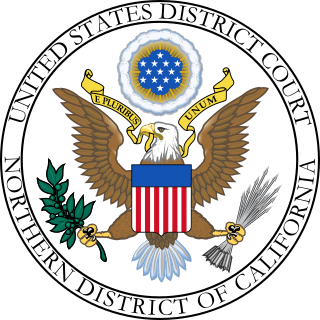Related Research Articles
A Usenet newsgroup is a repository usually within the Usenet system, for messages posted from users in different locations using the Internet. They are discussion groups and are not devoted to publishing news. Newsgroups are technically distinct from, but functionally similar to, discussion forums on the World Wide Web. Newsreader software is used to read the content of newsgroups.

There are a number of disputes concerning the Church of Scientology's attempts to suppress material critical of Scientology and the organization on the Internet, utilizing various methods – primarily lawsuits and legal threats, as well as front organizations. In late 1994, the organization began using various legal tactics to stop distribution of unpublished documents written by L. Ron Hubbard. The organization has often been accused of barratry through the filing of SLAPP suits. The organization's response is that its litigious nature is solely to protect its copyrighted works and the unpublished status of certain documents.
The Penet remailer was a pseudonymous remailer operated by Johan "Julf" Helsingius of Finland from 1993 to 1996. Its initial creation stemmed from an argument in a Finnish newsgroup over whether people should be required to tie their real name to their online communications. Julf believed that people should not—indeed, could not—be required to do so. In his own words:
alt.binaries.slack is a Usenet newsgroup created for the purpose of posting pictures, sounds, and utilities related to the Church of the SubGenius, making them available for everyone to see and hear. Because the Church of the SubGenius is well known for encouraging sick and twisted humor, the newsgroup is also home to artists who post humorous artwork of all sorts. A fair amount of the pictures on alt.binaries.slack are adult-oriented, and may be considered offensive by some viewers. The denizens of the newsgroup state that they enjoy deliberately offending those who are too easily offended.

Sporgery is the disruptive act of posting a flood of articles to a Usenet newsgroup, with the article headers falsified so that they appear to have been posted by others. The word is a portmanteau of spam and forgery, coined by German software developer, and critic of Scientology, Tilman Hausherr.

The Fishman Affidavit is a set of court documents submitted by self-professed ex-Scientologist Steven Fishman in 1993 in the federal case, Church of Scientology International v. Fishman and Geertz (Case No. CV 91-6426.
Newsgroup spam is a type of spam where the targets are Usenet newsgroups. Usenet convention defines spamming as excessive multiple posting, i.e. repeated posting of a message or very similar messages to newsgroups. The spam may be commercial advertisements, opinionated messages, malicious files, or nonsensical posts designed to disrupt the newsgroups. A type of newsgroup spam is sporgery which is intended to make the targeted newsgroups unreadable. The prevalence of Usenet spam led to the development of the Breidbart Index as an objective measure of a message's "spamminess", and attempts to purge newsgroups of spam.

Google Groups is a service from Google that provides discussion groups for people sharing common interests. Until February 2024, the Groups service also provided a gateway to Usenet newsgroups, both reading and posting to them, via a shared user interface. In addition to accessing Google groups, registered users can also set up mailing list archives for e-mail lists that are hosted elsewhere.

Arnaldo Pagliarini Lerma was an American writer and activist, a former Scientologist, and a critic of the Church of Scientology who appeared in television, media and radio interviews. Lerma was the first person to post the court document known as the Fishman Affidavit, including the Xenu story, to the Internet via the Usenet newsgroup alt.religion.scientology.
Tilman Hausherr is a German citizen living in Berlin, Germany. Hausherr is well known among critics of Scientology for his frequent Usenet posts and for maintaining a website critical of Scientology. Hausherr is also the author of a software utility, Xenu's Link Sleuth, which was praised in a 2002 PC Magazine article covering 70 web builder utilities.

Tory Christman is a prominent American critic of Scientology and former member of the organization. Originally brought up a Catholic, Christman turned to Scientology after being introduced to the book Dianetics: The Modern Science of Mental Health authored by Scientology founder L. Ron Hubbard while staying with her parents in Chicago. She identified with concepts described in the book including the idea of attaining the Scientology state of clear, and became a member of the organization in 1969. She hitchhiked from Chicago to Los Angeles, in order to begin the process of studying Scientology, and initially felt that it helped improve her life. In 1972, she joined the core group of staff members within Scientology called the Sea Org. After being a member of the Scientology organization for ten years, Christman reached the spiritual Operating Thetan level of OT III, and learned the story of Xenu. She subsequently rose to a higher Operating Thetan level of OT VII, the second-highest within the organization. Her medical condition of epilepsy caused difficulty while in Scientology, as the organization did not approve of taking medication in order to manage her condition.
Moxon & Kobrin is a "captive" law firm of the Church of Scientology, meaning that it has no other clients apart from Scientology-affiliated entities. Its headquarters are located in Los Angeles, California, in the Wilshire Center Business Improvement District. Its members are: Kendrick Moxon, Helena Kobrin, and Ava Paquette.

FACTnet, also known as Fight Against Coercive Tactics Network, co-founded by Robert Penny and Lawrence Wollersheim, was a Colorado-based anti-cult organization with the stated aim of educating and facilitating communication about destructive mind control. Coercive tactics, or coercive psychological systems, are defined on their website as "unethical mind control such as brainwashing, thought reform, destructive persuasion and coercive persuasion".
Control messages are a special kind of Usenet post that are used to control news servers. They differ from ordinary posts by a header field named Control. The body of the field contains control name and arguments.
Scieno Sitter is content-control software that, when installed on a computer, blocks certain websites critical of Scientology from being viewed. The software was released by the Church of Scientology in 1998 for Church members using Windows 95. The term "Scieno Sitter" was coined by critics of Scientology who assert that the program is a form of Internet censorship.
A Usenet personality was a particular kind of Internet celebrity, being an individual who gained a certain level of notoriety from posting on Usenet, a global network of computer users with a vast array of topics for discussion. The platform is usually anonymous, although users can get celebrity status, usually by being deemed different from other posters in some way.

Usenet, USENET, or, "in full", User's Network, is a worldwide distributed discussion system available on computers. It was developed from the general-purpose Unix-to-Unix Copy (UUCP) dial-up network architecture. Tom Truscott and Jim Ellis conceived the idea in 1979, and it was established in 1980. Users read and post messages to one or more topic categories, known as newsgroups. Usenet resembles a bulletin board system (BBS) in many respects and is the precursor to the Internet forums that have become widely used. Discussions are threaded, as with web forums and BBSes, though posts are stored on the server sequentially.

Operation Clambake, also referred to by its domain name, xenu.net, is a website and Norway-based non-profit organization, launched in 1996, founded by Andreas Heldal-Lund, that publishes criticism of the Church of Scientology. It is owned and maintained by Andreas Heldal-Lund, who stated that he supported the rights of all people to practice Scientology or any religion. Operation Clambake has referred to the Church of Scientology as "a vicious and dangerous cult that masquerades as a religion". The website includes texts of petitions, news articles, exposés, and primary source documents. The site has been ranked as high as the second spot in Google searches for the term "Scientology".

Religious Technology Center v. Netcom On-Line Communication Services, Inc., 907 F. Supp. 1361, is a U.S. district court case about whether the operator of a computer bulletin board service ("BBS") and Internet access provider that allows that BBS to reach the Internet should be liable for copyright infringement committed by a subscriber of the BBS. The plaintiff Religious Technology Center ("RTC") argued that defendant Netcom was directly, contributorily, and vicariously liable for copyright infringement. Netcom moved for summary judgment, disputing RTC's claims and raising a First Amendment argument and a fair use defense. The district court of the Northern District of California concluded that RTC's claims of direct and vicarious infringement failed, but genuine issues of fact precluded summary judgment on contributory liability and fair use.
A series of incidents in 2009 led to Church of Scientology–owned networks being blocked from making edits to Wikipedia articles relating to Scientology. The Church of Scientology has long had a controversial history on the Internet and had initiated campaigns to manipulate material and remove information critical of itself from the web. From early in Wikipedia's history, conflict arose regarding the website's coverage of Scientology. Disputes began in earnest in 2005, with users disagreeing about whether or not to describe Scientology as an abusive cult or religion, and continued through the decade.
References
- ↑ official logs from the Internet Software Consortium
- 1 2 3 4 5 Grossman, Wendy M. (December 1, 1995). "alt.scientology.war". Wired magazine . Archived from the original on April 23, 1999.
- 1 2 3 Cusack, Carole M. (August 2012). "Media Coverage of Scientology in the United States". In Winston, Diane (ed.). The Oxford Handbook of Religion and the American News Media. pp. 303–316. doi:10.1093/oxfordhb/9780195395068.013.0020. ISBN 9780195395068.
- ↑ "alt.religion.scientology". Google Groups. Retrieved July 5, 2024.
- ↑ John P. (February 10, 2018). "Evolution of Scientology Opposition, 1968-2018". Reasoned.Life.
- ↑ Stryker, Cole (2012). Epic Win for Anonymous: How 4chan's Army Conquered the Web. Gerald Duckworth & Company. ISBN 9780715642832. OL 26825878M.
- 1 2 Grossman, Wendy (1997). "Copyright Terrorists". Net.Wars. New York: New York University Press. pp. 77–78. ISBN 0-8147-3103-1. OL 675037M.
- ↑ Helena Kobrin (January 12, 1995). "cmsg rmgroup alt.religion.scientology". Newsgroup: alt.config. Usenet: hkkD29vI1.Mo9@netcom.com.
- ↑ Swamp Ratte (June 4, 1995). "A statement from Cult of the Dead Cow". Archived from the original on March 16, 2006.
- ↑ Hicks, Jesse (September 20, 2015). "How the Church of Scientology fought the Internet—and why it lost". The Kernel . Archived from the original on November 13, 2020.
- 1 2 3 4 Prendergast, Alan (October 4, 1995). "Hunting rabbits, serving spam: The net under siege". Denver Westword News . Village Voice Media. Archived from the original on March 15, 2008. Retrieved February 1, 2008.
- ↑ Jones, Colman (July 4, 1996). "Freedom Flames Out on the 'Net". NOW Magazine . Archived from the original on January 29, 2008. Retrieved February 1, 2008.
- ↑ "Google Groups". groups.google.com.
- ↑ Brown, Janelle (July 15, 1998). "A Web of their own". Salon. Archived from the original on October 15, 2015.
- ↑ Ortega, Tony (September 9, 2001). "Sympathy for the Devil". New Times LA . (courtesy link)
